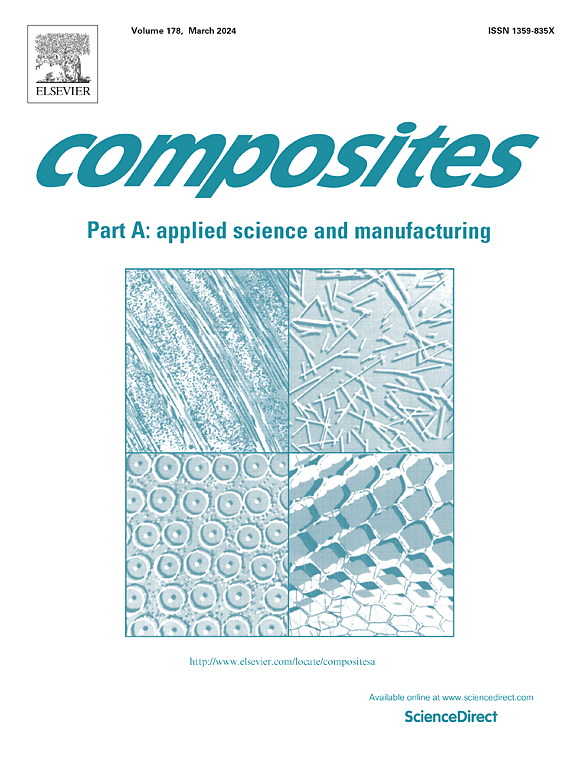Design and manufacturing of bio-inspired functionally graded ceramic-reinforced resin post-and-core restorations
IF 8.1
2区 材料科学
Q1 ENGINEERING, MANUFACTURING
Composites Part A: Applied Science and Manufacturing
Pub Date : 2025-04-02
DOI:10.1016/j.compositesa.2025.108889
引用次数: 0
Abstract
This study developed a functionally graded post-and-core system using urethane dimethacrylate resins reinforced with zirconia (ZrO2) nanoparticles, with material design guided by finite element (FE) modeling. Three groups were established according to the post-and-core materials and techniques: FPC, prefabricated fiber post plus resin composite core; HPC, CAD/CAM homogeneous post-and-core; GPC, CAD/CAM graded post-and-core. The machinability assessment validated the dimensional accuracy of experimental CAD/CAM posts by showing an undetectable marginal discrepancy of less than 40 µm and the good adhesion between the sequentially deposited layers for graded post-and-core. FE analysis and in vitro failure test were performed to compare the biomechanical performance of the restored teeth using three restorations. FE analysis indicated that the GPC group with tri-layer configuration (coronal–apical dimensions: 6–4–3 mm) and corresponding elastic modulus (9.8–8.5–6.7 GPa) achieved optimal stress distribution patterns, outperforming both FPC and HPC groups. In vitro tests revealed that both GPC and HPC groups possessed uniform adhesive layers and favorable root repairable failure rates of 33 %, significantly higher than the rate of 0 % observed in FPC group. This functionally graded approach effectively addresses the biomechanical mismatch along the corono-apical direction of tooth roots by tailoring material properties, offering a strategy for the next-generation post-and-core restorations. The successful development of CAD/CAM graded composites demonstrates significant potential for advanced restorative applications with good clinical performance.
仿生功能梯度陶瓷增强树脂桩核修复体的设计与制造
本研究开发了一种功能分级的桩核系统,采用二甲基亚酯树脂和氧化锆(ZrO2)纳米颗粒增强,材料设计以有限元(FE)模型为指导。根据桩芯材料和工艺分为三组:FPC,预制纤维桩+树脂复合桩芯;HPC、CAD/CAM均质桩核;GPC, CAD/CAM分级桩芯。可加工性评估验证了实验CAD/CAM桩的尺寸精度,显示了小于40µm的不可检测的边际差异,以及分级桩芯顺序沉积层之间良好的附着力。采用有限元分析和体外破坏试验比较三种修复体修复牙的生物力学性能。有限元分析表明,三层结构的GPC组(冠顶尺寸:6-4-3 mm)和相应的弹性模量(9.8 ~ 8.5 ~ 6.7 GPa)的应力分布模式最优,优于FPC和HPC组。体外实验结果表明,GPC组和HPC组均具有均匀的粘附层,良好的根可修复失败率为33%,显著高于FPC组的0%。这种功能分级的方法通过调整材料特性,有效地解决了牙根冠尖方向的生物力学不匹配问题,为下一代桩核修复提供了一种策略。CAD/CAM分级复合材料的成功开发显示了具有良好临床性能的高级修复应用的巨大潜力。
本文章由计算机程序翻译,如有差异,请以英文原文为准。
求助全文
约1分钟内获得全文
求助全文
来源期刊

Composites Part A: Applied Science and Manufacturing
工程技术-材料科学:复合
CiteScore
15.20
自引率
5.70%
发文量
492
审稿时长
30 days
期刊介绍:
Composites Part A: Applied Science and Manufacturing is a comprehensive journal that publishes original research papers, review articles, case studies, short communications, and letters covering various aspects of composite materials science and technology. This includes fibrous and particulate reinforcements in polymeric, metallic, and ceramic matrices, as well as 'natural' composites like wood and biological materials. The journal addresses topics such as properties, design, and manufacture of reinforcing fibers and particles, novel architectures and concepts, multifunctional composites, advancements in fabrication and processing, manufacturing science, process modeling, experimental mechanics, microstructural characterization, interfaces, prediction and measurement of mechanical, physical, and chemical behavior, and performance in service. Additionally, articles on economic and commercial aspects, design, and case studies are welcomed. All submissions undergo rigorous peer review to ensure they contribute significantly and innovatively, maintaining high standards for content and presentation. The editorial team aims to expedite the review process for prompt publication.
 求助内容:
求助内容: 应助结果提醒方式:
应助结果提醒方式:


